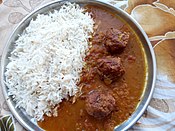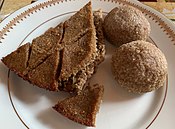Kofta

Kofta is a family of
There are many national and regional variations. There are also vegetable and uncooked versions. Shapes vary and include balls, patties, and cylinders. Sizes typically vary from that of a golf ball to that of an orange.
Etymology
In English, kofta is a loanword borrowed from the Hindi-Urdu कोफ़्ता / کوفتہ and Persian کوفته kofta meaning pounded meat.[2][3][4][1] The earliest extant use of the word in the Urdu language is attested from the year 1665 in Mulla Nusrati's ʿAlī Nāma.[5][6] It was first used in English in Qanoon-e-Islam in 1832,[7] and then by James Wise in 1883.[8] The languages of the region of the kofta's origin have adopted the word with minor phonetic variations.[9] Similar foods are called in other languages croquettes, dumplings, meatballs, rissoles, and turnovers.[9][10]
History
The ancient Roman cookbook Apicius included many meatball-type recipes.[11]
The first appearance of recipes for kofta are in the earliest Arab cookbooks.[12][9] The earliest recipes are for large ground lamb meatballs triple-glazed in a mixture of saffron and egg yolk.[12] This glazing method spread to the West, where it is referred to as "gilding" or "endoring".[9] Koftas moved to India; according to Alan Davidson, Nargisi Kofta was served at the Mughal court.[9]
Koftas are found from the Indian subcontinent through Central Asia, the Middle East, the Balkans, and northern Africa.
Variations
Generally meat is mixed with spices and often other ingredients such as rice,
Examples
- Chiftele, a Romanian version using ground pork mixed with mashed potatoes.
- Çiğ köfte, a Turkish and Armenian version made with bulgur and sometimes raw meat.
- style of kofta, typically made from ground beef or ground lamb, and served with a side of cooked potatoes and a salad.
- İnegöl köfte, a Turkishstyle of kofta.
- Islama köfte, a steamed kofta from Turkey.
- Kibbeh, a Middle Eastern dish in which includes kofte, sometimes served raw.
- Analı kızlı, a Turkish soup.
- Kofte Chawal, an mutton.[21]
- Koofteh Berenji, Koofteh Hamedani, Koofteh Nar,
- Malai kofta[24]
- Nargisi Kofta, an Indian subcontinental dish in which a hard-boiled egg is wrapped in the kofta mixture.[9]
- Pishtha, a meatball mentioned in the Sushrutha Samhita.[25]
- Şiş köfte, a Turkishkebab-style kofta.
- Sulu köfte, a Turkish kofta soup or stew.
- Tabriz köftesi, an Azerbaijani version unusual for its average diameter of 20 centimetres (8 in).[9]
- Tomatokeftedes, a Greek vegetarian version of kofta which uses tomatoes.[26]
- Ktzitzot Khubeza - an Israelikofta made of mallow, garlic and bread crumbs mixed with egg whites and yolks.
- Küfte, кюфте in Crimean Tatar cuisine (Crimea, Ukraine).
- Meatball, As commonly known in America.
-
Malai Kofta, a dish common in the Cuisine of the Indian subcontinent
-
Iranian Tabrizi Kofta include: yellow split peas and potatoes, as well as minced meat.
-
Kofte Chawal from India (vegetarian kofta made with Bottle Gourd), served with rice.
-
Egyptian cigar-shaped kofta stuffed in a pita.
-
Armenian types of kofte
See also
- List of meatball dishes
- Bobotie
- Ćevapi
- Ćufte
- Falafel
- Frikadeller
- Hamburg steak
- Kabab koobideh
- Mititei
- Salisbury steak
- Scotch egg
- Shami kebab
- Shish taouk
- Yuvarlakia
References
- ^ ISBN 978-0-19-280025-1.
In Indian cookery, the term kofta denotes a spiced meatball, or a similarly shaped mass of chopped fish or vegetable, cooked in a spicy sauce. In Hindi, the word means literally 'pounded meat'.
- ^ "kofta". Oxford English Dictionary. 2023. Retrieved 27 December 2023.
The earliest known use of the noun kofta is in the 1880s. OED's earliest evidence for kofta is from 1888, in the writing of W. H. Dawe. kofta is a borrowing from Hindi. Etymons: Hindi kofta.
- ISBN 978-0-19-960111-0.
- ^ Origin of Kofte ,Turkish köfte Arabic kufta and Hindi and Urdu koftā all from Persian kōfta (Persian kūfte) from passive participle of kōftan to pound, bray.
- ^ Nuṣratī, Mullā (1665). ʿAlī Nāma علی نامہ (in Urdu). p. 234.
Na tha har ġalūla nibolī te kam / Rakhe kofte [pl.] bār golīyāṅ te jam
- ^ Fatehpuri, Farman, ed. (June 1993) [22 vols pub. 1977–2010]. "kofta" کوفتہ. Urdu Lughat (Tareekhi Usool Par) [Urdu Dictionary on Historical Principles] (in Urdu). Vol. 15. Urdu Dictionary Board.
- Parbury, Allen, and Co.p. xxx. pp. xxvii, xxx:
V. Moosulman [Muslim] Cookery, (including the various Dishes alluded to in this Work). 1. Polaoos پلاؤ. ... Kofta Polaoo کوفتہ پلاؤ.
- ^ Wise, James (1883). "Nán-baí, Roṭi-wálah". Notes on the Races, Castes and Trades of Eastern Bengal. London, England: Harrison and Sons. p. 97.
[The Nān-bāʾī's] bill of fare includes a delicious, richly-flavoured curry, Kofta, or pounded meat, roasts, and puláos. ... Koftá—hashed or pounded, and fried in Ghí.
- ^ )
- ^ )
- ISBN 1-903018-44-7, p. 17-18
- ^ OCLC 1139766078.)
{{cite book}}: CS1 maint: location missing publisher (link - ^ a b c d e Dea, Cynthia (9 March 2015). "Where to Find the Best Meatballs in Los Angeles". KCET. Retrieved 24 August 2021.
- ^ a b c d Tsaturyan, Ruzanna (23 June 2017). "A culinary conflict in the South Caucasus". OpenDemocracy. Retrieved 24 August 2021.
- ISBN 0195644166.
- ^ Fatima, Bushra (30 June 2015). "Pakistanis' love for the succulent kofta curry". The Express Tribune. Archived from the original on 10 July 2020. Retrieved 5 July 2020.
- Atlas Media. Retrieved 24 August 2021.
- ^ OCLC 921994379.
- ISBN 9781449618117.
- ^ Abdel Fattah, Iman Adel (5 December 2013). "Bites Fil Beit: Koftet el Gambari – Shrimp kofta". Daily News Egypt. Archived from the original on 3 May 2015. Retrieved 19 April 2015.
- ^ a b Fatima, Bushra (30 June 2015). "Pakistanis' love for the succulent kofta curry". The Express Tribune. Archived from the original on 10 July 2020. Retrieved 5 July 2020.
- OCLC 1202053063.)
{{cite book}}: CS1 maint: location missing publisher (link - ^ "طرز تهیه کوفته و انواع آن در شهرهای ایران". Kojaro.
- ^ "Malai Kofta Recipe". Swasthi's Recipes. 27 August 2017.
- ISBN 0195644166.
- ^ Aglaia Kremezi and Anissa Hellou, 'What's in the Name of the Dish' in Richard Hosking (ed.), Food and Language: Proceedings of the Oxford Symposium on Food and Cooking 2009 (London: Prospect Books, 2010) 206






